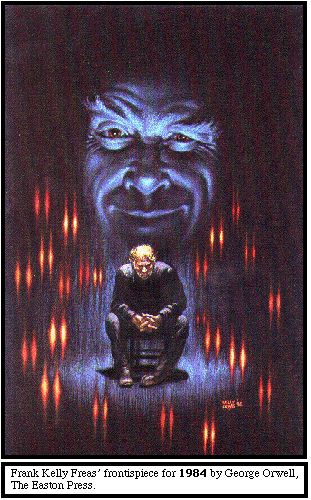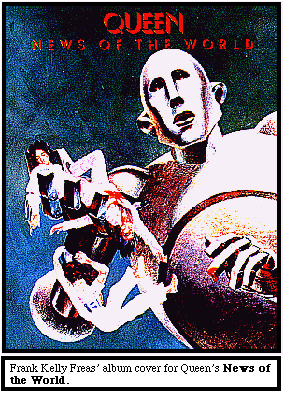The Story Between the Words
by Frank Kelly Freas
Frank Kelly Freas career as a science fiction and fantasy artist spans
forty years. He began with painting covers for Astounding Science-Fiction
and Planet Stories in the 1950s. Over the years, Freas' art has
graced the covers of hundreds of science fiction books and magazines including
works by Isaac Asimov and Arthur C. Clark. He also contributed covers to
Mad Magazine from 1955 to 1962, as well as numerous other commercial
illustrations, such as the record jacket for Queen's best-selling album,
News of the World, and the cover of the 1992 Star Trek Annual.
An official NASA artist, Freas' space posters hang in the Smithsonian Museum,
Washington. He was also commissioned by the Skylab I astronauts
to design their crew patch. Freas has won ten Hugo Awards, the highest
recognition granted to a science fiction artist. In 1994, Starlog
magazine included him in their prestigious list of The 200 Most Important
People in Science Fiction and Fantasy. Please contact Frank Kelly Freas
at ao891@lafn.org or http://www.concentric.net/~3dstereo/freas.shtml
Now why in the world would anybody want to be a science fiction illustrator,
anyway? There's more money in lots of places, and sometimes just as much
fun -- like painting pinup girls.
There is basically only one reason for doing science fiction. It is
simply more interesting, more challenging, more exciting, and less restricting
than any other genre of illustration.
I have written (elsewhere and often) about the opportunity illustration
offers the artist to move outside the limitations of mere self-expression,
into an area where he can apply his abilities to the concerns of his whole
culture. Consider, in what area but science fiction could the artist have
such an opportunity to add a visual dimension to the endless variety of
ideas being generated by some of the finest minds in the world?
Science fiction offers a chance to have a positive impact on our culture,
bypassing both jellified thought-patterns and the frequently justifiable
reluctance of the general market to consider anything very far off trail.
That science fiction both as art and literature has begun to get more general
acceptance doesn't indicate a broader-minded public. It just means that
the general public is more aware of us and our ideas through the media.
It would be even nicer if it was able to read, but let us nevertheless
be duly grateful.
 More than any other segment of the art world, and in spite of operating
on its fringes, we have both a high degree of freedom to act and a reasonable
chance of having an effect on the culture itself.
Why do I stress illustration over easel painting? Can't the mainstream
artist have as much freedom and import as we can? Bluntly, no. Because
the publications through which we work disseminate the ideas we
illustrate -- and eventually come back to us through cartoons, movies,
videos,comics, etc. In the non-SF or real world you'd have to be
a serial axe murderer to get the coverage we get routinely -- and it wouldn't
last as long. Ask Michelangelo....
Throughout history, the artist has always been an illustrator.
(Just think for a moment how in seven thousand years of art, the art gallery
has been with us for over a hundred). Art has typically been a reflection
of the world in which the artist found himself.
To date, the majority of stories readily available to use have been
rooted in a Western cultural framework. I think you would agree that for
good or ill, 2000+ years of Western thought has been based on Judeo-Christian
philosophy/mythology and the United States is -- and probably shall continue
to be for a while at least -- an essentially Western culture. The effectiveness
and continuity of any culture is founded upon the ability of its members
to communicate with each other. I don't think science fiction (or fact
for that matter) has quite reached the stage of McLuhan's "global
village", but we are becoming an international information exchange.
Since communication itself is based upon a body of shared symbolism, much
of which abides at the unconscious level, we obviously need to become familiar
with the nature and variety of thought patterns of the rest of the planet.
We do not exist in a one-culture world. For example, it is going to become
essential for us to learn and use the mythology of the East, and there
can hardly be an easier or more direct method of doing so than through
the visual techniques which are the illustrator's stock in trade. We hope.
Even English alone is hard enough to put into potent visual imagery.
As a dedicated professional illustrator for over forty years, I am
painfully aware of the need for knowledge of this basic symbolism in order
to translate verbal expression of ideas into immediately effective visual
terms. In fact, in the last decade and a half, more of less, I have found
to my chagrin that what seemed to be an obvious reference was totally lost
on my new generation of readers. This is a real and continuing problem,
and shows every likelihood of getting worse.
For instance, what could be more obvious than my reference to Alfred
Lord Tennyson's poem by titling my Skylab poster "The Wonder
That IS"? Apparently, anything. Doesn't anyone read Tennyson anymore?
Then to compound the stupidity, I titled my second collection of science
fiction cover art A Separate Star, and got my tail thoroughly chewed
by a couple of courageous friends. The pointed out that the juxtaposition
of "Frank Kelly Freas" and "A Separate Star" conveyed
a message of personal horn-blowing considerably more familiar to the public
than Kipling's poem, which concludes:
More than any other segment of the art world, and in spite of operating
on its fringes, we have both a high degree of freedom to act and a reasonable
chance of having an effect on the culture itself.
Why do I stress illustration over easel painting? Can't the mainstream
artist have as much freedom and import as we can? Bluntly, no. Because
the publications through which we work disseminate the ideas we
illustrate -- and eventually come back to us through cartoons, movies,
videos,comics, etc. In the non-SF or real world you'd have to be
a serial axe murderer to get the coverage we get routinely -- and it wouldn't
last as long. Ask Michelangelo....
Throughout history, the artist has always been an illustrator.
(Just think for a moment how in seven thousand years of art, the art gallery
has been with us for over a hundred). Art has typically been a reflection
of the world in which the artist found himself.
To date, the majority of stories readily available to use have been
rooted in a Western cultural framework. I think you would agree that for
good or ill, 2000+ years of Western thought has been based on Judeo-Christian
philosophy/mythology and the United States is -- and probably shall continue
to be for a while at least -- an essentially Western culture. The effectiveness
and continuity of any culture is founded upon the ability of its members
to communicate with each other. I don't think science fiction (or fact
for that matter) has quite reached the stage of McLuhan's "global
village", but we are becoming an international information exchange.
Since communication itself is based upon a body of shared symbolism, much
of which abides at the unconscious level, we obviously need to become familiar
with the nature and variety of thought patterns of the rest of the planet.
We do not exist in a one-culture world. For example, it is going to become
essential for us to learn and use the mythology of the East, and there
can hardly be an easier or more direct method of doing so than through
the visual techniques which are the illustrator's stock in trade. We hope.
Even English alone is hard enough to put into potent visual imagery.
As a dedicated professional illustrator for over forty years, I am
painfully aware of the need for knowledge of this basic symbolism in order
to translate verbal expression of ideas into immediately effective visual
terms. In fact, in the last decade and a half, more of less, I have found
to my chagrin that what seemed to be an obvious reference was totally lost
on my new generation of readers. This is a real and continuing problem,
and shows every likelihood of getting worse.
For instance, what could be more obvious than my reference to Alfred
Lord Tennyson's poem by titling my Skylab poster "The Wonder
That IS"? Apparently, anything. Doesn't anyone read Tennyson anymore?
Then to compound the stupidity, I titled my second collection of science
fiction cover art A Separate Star, and got my tail thoroughly chewed
by a couple of courageous friends. The pointed out that the juxtaposition
of "Frank Kelly Freas" and "A Separate Star" conveyed
a message of personal horn-blowing considerably more familiar to the public
than Kipling's poem, which concludes:

 I use whatever method suits the present assignment, as well as the
state of my liver at the moment. Which ever way you go, just don't you
dare be wishy-washy about it. To illustrate is to be deliberate: you pick
your subject and method, and you stick with them, right or wrong, for that
job.
I use whatever method suits the present assignment, as well as the
state of my liver at the moment. Which ever way you go, just don't you
dare be wishy-washy about it. To illustrate is to be deliberate: you pick
your subject and method, and you stick with them, right or wrong, for that
job.
![]()